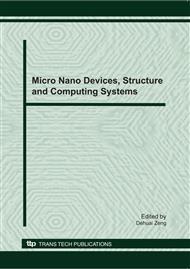p.383
p.388
p.393
p.399
p.406
p.412
p.420
p.424
p.429
Analysis and Design of Drive Closed-Loop for MEMS Vibratory Gyroscope
Abstract:
The principle of drive closed-loop for tuning fork comb MEMS vibratory gyroscope is analyzed. The core of the closed-loop is to keep the vibration speed stable by adding driving force offset the damping force. The closed-loop with a single Automatic Gain Control (AGC) loop is chosen to maintain the vibration speed stable, and then the closed-loop with AGC is analyzed to obtain its transfer function. The transfer function simplifies the nonlinear AGC system to a linear system which is easy analyzed its parameters impacting the system. The values of two important parameters of AGC were chosen via simulation. The whole closed-loop system was simulated in SIMULINK. The circuit is built and tested in accordance with the theory of analysis and simulation. Experimental results demonstrate that the stability of the amplitude of vibration speed is 90ppm; and that of the frequency of vibration speed is 114ppm.
Info:
Periodical:
Pages:
406-411
Citation:
Online since:
December 2010
Authors:
Price:
Сopyright:
© 2011 Trans Tech Publications Ltd. All Rights Reserved
Share:
Citation:


